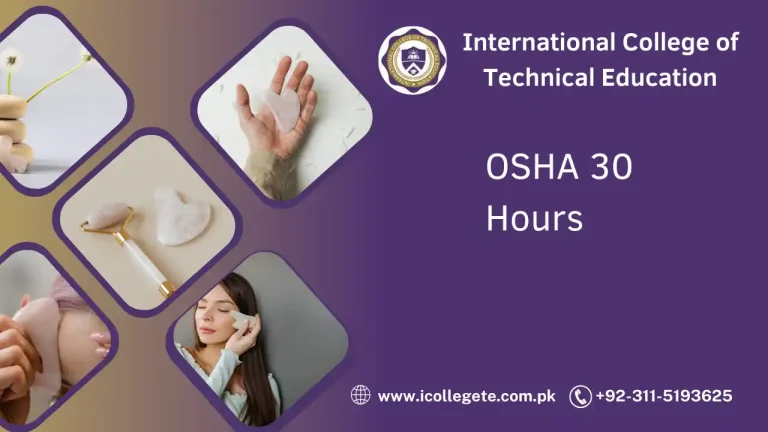In today’s fast-paced and increasingly complex work environments, ensuring the safety and well-being of employees is more crucial than ever. Whether you’re working in construction, manufacturing, or any high-risk industry, understanding safety standards and regulations is essential for preventing accidents and ensuring a secure workplace. One of the best ways to enhance workplace safety knowledge is through the OSHA 30-Hour (Occupational Safety & Health Administration) course, and for professionals in Faisalabad, this training can be an invaluable investment.
The OSHA 30-Hour Occupational Safety & Health Administration (OSHA 30-Hour) course is an advanced-level training program designed to provide employees and supervisors with the knowledge they need to create and maintain a safe and compliant workplace. This course is primarily aimed at those in leadership roles or those responsible for ensuring safety at the workplace. It provides comprehensive training on the identification, avoidance, and prevention of workplace hazards.
The OSHA 30-Hour course in Faisalabad focuses on building expertise in occupational safety regulations and compliance, giving participants a deeper understanding of workplace safety hazards and how to mitigate them. By completing this course, participants receive an official OSHA 30-Hour certification, which is recognized and respected across various industries, ensuring that they are well-equipped to enhance safety protocols and comply with OSHA regulations.
Course Overview:
The OSHA 30-Hour course offers extensive coverage of safety principles and regulations, with a particular focus on industry-specific hazards, safety standards, and the implementation of safety measures. The course is designed to provide an in-depth understanding of OSHA regulations, emphasizing the importance of a safety culture in the workplace.
Key Features of the Course:
- Comprehensive Safety Training: Learn about various workplace hazards, including electrical safety, fall protection, material handling, and more.
- Risk Assessment and Prevention: Understand how to identify risks, assess hazards, and implement measures to prevent accidents.
- Regulatory Compliance: Gain knowledge of OSHA regulations, ensuring that your workplace is fully compliant with federal safety standards.
- Management and Supervision Skills: Develop leadership skills to manage safety programs, conduct safety meetings, and ensure adherence to safety protocols.
- Interactive Learning: The course includes practical exercises and case studies to reinforce safety concepts and best practices.
Study Units:
The OSHA 30-Hour course is broken down into various study units that cover both general safety principles and specific topics relevant to different industries. Here’s an outline of the primary study units:
- Unit 1: Introduction to OSHA and Safety Regulations
- Overview of OSHA’s role in ensuring workplace safety.
- Understanding OSHA standards and the importance of compliance.
- The rights and responsibilities of workers and employers under OSHA.
- Unit 2: Workplace Safety Hazards
- Identifying and managing workplace hazards (e.g., chemical hazards, electrical hazards, biological hazards).
- Understanding and controlling hazardous materials and substances.
- Unit 3: Personal Protective Equipment (PPE)
- Proper use, selection, and maintenance of PPE.
- Understanding the importance of PPE in preventing injuries and illnesses.
- Unit 4: Fire Safety and Emergency Procedures
- Fire prevention and safety measures in the workplace.
- Emergency response planning, including evacuation and first aid protocols.
- Unit 5: Fall Protection and Scaffold Safety
- Safety measures for working at heights.
- Proper installation, maintenance, and use of fall protection systems.
- Scaffold safety and inspection.
- Unit 6: Electrical Safety
- Identifying electrical hazards and the importance of proper maintenance.
- Ensuring safe electrical work practices to prevent accidents and injuries.
- Unit 7: Material Handling and Ergonomics
- Safe lifting and carrying techniques to prevent musculoskeletal injuries.
- Addressing ergonomics in the workplace to reduce the risk of repetitive strain injuries.
- Unit 8: Construction Site Safety
- Managing and implementing safety protocols in construction environments.
- Hazardous material handling, excavation safety, and more.
- Unit 9: Health and Environmental Safety
- Occupational health issues (e.g., respiratory protection, noise hazards, and other environmental factors).
- Environmental regulations and sustainable workplace practices.
- Unit 10: Accident Investigation and Reporting
- Techniques for investigating workplace accidents and injuries.
- Properly documenting and reporting incidents according to OSHA guidelines.
Learning Outcomes:
Upon completing the OSHA 30-Hour course, participants will be able to:
- Identify and assess workplace hazards across various industries, including construction, manufacturing, and healthcare.
- Understand OSHA regulations and safety standards, ensuring compliance with workplace safety laws.
- Implement and maintain safety programs, including the selection and use of appropriate personal protective equipment (PPE).
- Prevent accidents and injuries by recognizing risks and developing safety plans to mitigate those risks.
- Conduct effective safety meetings and training for employees to foster a safety-first culture.
- Develop an emergency response plan, including proper fire safety and evacuation procedures.
- Lead and manage a team in creating a safe work environment, ensuring that workers adhere to safety protocols.
Course Benefits:
Enrolling in the OSHA 30-Hour course provides several key benefits that enhance workplace safety knowledge and career development:
- Comprehensive Safety Knowledge: The course offers an in-depth understanding of safety protocols, hazard management, and regulatory compliance.
- OSHA Certification: Upon successful completion, participants receive an official OSHA 30-Hour Certification, which is highly regarded by employers across various industries.
- Career Advancement: Gaining an OSHA 30-Hour certification can open the door to higher-paying roles in safety management, health, and environmental compliance.
- Improved Safety Culture: As a graduate of the course, you’ll be better equipped to promote a culture of safety in your workplace, reducing workplace accidents and enhancing employee well-being.
- Industry Recognition: OSHA certifications are widely recognized in industries like construction, manufacturing, and healthcare, which improves your employability and career prospects.
- Risk Mitigation: The course teaches you how to prevent accidents and identify hazards before they become dangerous, which leads to a safer work environment.
Who is This Course For?
The OSHA 30-Hour course is ideal for:
- Managers and Supervisors: Individuals in leadership positions who are responsible for ensuring workplace safety and compliance with OSHA standards.
- Safety Officers and Health & Safety Managers: Professionals whose role focuses on overseeing safety programs and ensuring their organization adheres to safety regulations.
- Construction Professionals: Contractors, engineers, and other workers in the construction industry who need to understand and implement OSHA regulations.
- Human Resource and Compliance Professionals: HR professionals who oversee safety training and compliance in the workplace.
- Workers in High-Risk Industries: Employees working in manufacturing, oil & gas, chemicals, or other hazardous work environments who want to improve safety awareness.
- Anyone Interested in Occupational Safety: Individuals seeking to enter the safety management field and build a career in health and safety.
Future Progression:
Upon completing the OSHA 30-Hour course, you will have the foundation to pursue further career advancements in safety and risk management. Here are some possible progression routes:
- OSHA 40-Hour Construction Safety Course: For those who want to expand their knowledge further and specialize in construction-specific safety protocols.
- Certified Safety Professional (CSP): Pursue higher certifications like the CSP for those looking to move into higher-level safety management roles.
- Health and Safety Manager/Director: Progress into managerial roles overseeing safety operations and compliance across an organization.
- Certified Industrial Hygienist (CIH): Specialize in the health aspects of safety, focusing on preventing workplace-related illnesses and injuries.
- Environmental Safety Specialist: Transition into environmental health and safety roles, focusing on sustainable practices and compliance with environmental regulations.
The OSHA 30-Hour course in Faisalabad offers a comprehensive, detailed approach to workplace safety, designed to help individuals in supervisory roles and high-risk industries create safer environments. With in-depth training on hazard identification, OSHA regulations, and safety management, this course is invaluable for those seeking to improve their safety knowledge and career prospects. By completing this course, you will be prepared to handle the safety challenges of any workplace and take on leadership roles in ensuring a compliant and risk-free environment.







